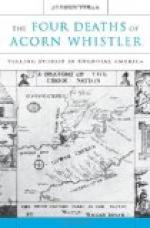“Here, gentlemen,” he said, “is one of the works which have been maligned.”
“Pardon me,” interposed Mr. Ruskin’s lawyer; “you have that picture upside down.”
“No such thing!”
“Oh, but it is so!” continued Ruskin’s counsel. “I remember it in the Grosvenor Gallery, where it was hung the other way about.”
The altercation ended in the correctness of view of Ruskin’s lawyer being sustained. This error of counsel helped to produce the celebrated farthing verdict. Ever after Whistler wore the farthing on his watch-chain.
* * * * *
The suit had its origin in Ruskin’s comment upon the “Nocturne in Black and Gold,” described as “a distant view of Cremorne Garden, with a falling rocket and other fireworks.” The picture is now the property of Mrs. Samuel Untermyer, of New York. On the opening of the Grosvenor Gallery, in 1877, Ruskin wrote in Fors Clavigera: “The ill-educated conceit of the artist nearly approached the aspect of wilful imposture. I have seen and heard much of cockney impudence before now, but never expected to have a coxcomb ask two hundred guineas for flinging a pot of paint in the public’s face.”
When Whistler was being examined during the trial, Sir John Holker, the Attorney-General, asked, “How long did it take you to knock off that ’Nocturne’?”
“I beg your pardon?” said the witness.
Sir John apologized for his flippancy, and Whistler replied: “About a day. I may have put a few touches to it the next day.”
“For two days’ labor you ask two hundred guineas?”
“No, I ask it for the knowledge of a lifetime!”
Then the “Nocturne in Blue and Silver,” a moonlight view of Battersea Bridge, was submitted to the jury. Baron Huddleston, the presiding justice, asked Mr. Whistler to explain it.
“Which part of the picture is the bridge?” he queried. “Do you say this is a correct representation?”
“I did not intend it to be a correct portrait of the bridge.”
“Are the figures on the top intended for people?”
“They are just what you like.”
“Is that a barge beneath?”
“Yes,” replied the witness, sarcastically. “I am much encouraged at your perceiving that! My whole scheme was only to bring out a certain harmony of color.”
“What is that gold-colored mark on the side, like a cascade?”
“That is a firework.”
“Do you think now,” said the Attorney-General, insinuatingly, “you could make me see the beauty of that picture?”
“No,” said Whistler, after closely scrutinizing his questioner’s face. “Do you know, I fear it would be as hopeless as for the musician to pour his notes into a deaf man’s ear.”
“What is that structure in the middle?” asked the irritated attorney. “Is it a telescope or a fire-escape? Is it like Battersea Bridge? What are the figures at the top? If they are horses and carts, how in the name of fortune are they to get off?”




